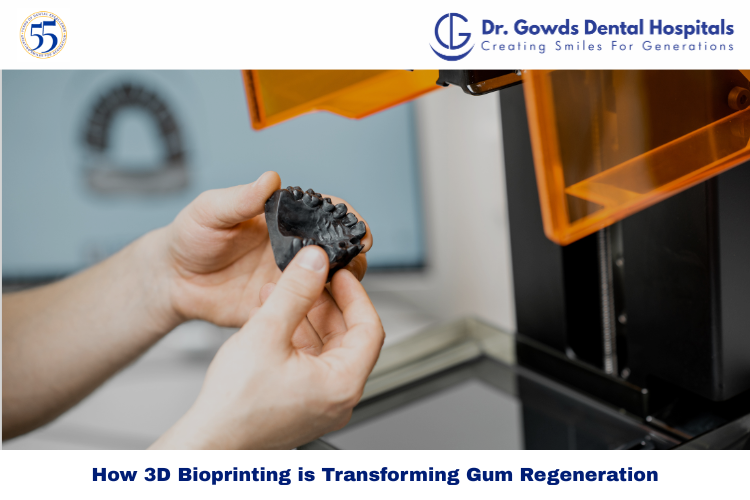Schedule Appointment




3D bioprinting is rebuilding the view of dental care, and Dr. Gowds Dental Hospital is at the forefront of this innovation. With the ability to create living gum tissue through precise layering of bioink and biocompatible materials, 3D bioprinting offers groundbreaking solutions for periodontal regeneration.
3D bioprinting refers to use of advanced printing technology to fabricate living tissue structures. In dentistry, this creation tailored gum tissue that can be utilized in some methods like gum grafts, providing a alternative to traditional methods. By combining tissue engineering and regenerative dentistry, 3D bioprinting technology addresses gum tissue loss due to periodontal disease or injury. Instead of gathering tissue from a donor site, dentists can print biocompatible structures using specialized bioink, reducing patient discomfort and surgical complications.
Dental bioprinting begins with a 3D scan of the patient’s oral structure. This scan directs the printer in constructing a soft tissue model using bioink made of living cells and supportive materials. The printed gum tissue imitates the properties of natural gingiva, encouraging proper integration with the existing tissues.
At Dr. Gowds Dental Hospitals, these technologies are created with the precision needed for complex periodontal regeneration cases. The result a customized graft that enhances both functionality and elegancy. The use of biocompatible materials ensures long-term safety and compatibility.
These applications represent a shift toward high-tech, patient-focused solutions in modern dentistry.
While 3D bioprinting offers incredible promise, there are still limitations. Complex vascularization is one of the biggest hurdles—ensuring the printed tissue integrates with blood vessels naturally is a significant challenge. Additionally, while early studies are encouraging, long-term data is still being gathered to ensure lasting success.
Other barriers include regulatory approval processes, the cost of equipment, and training requirements for dental professionals. Despite these obstacles, continued advancements in tissue engineering, software algorithms, and printer precision are steadily overcoming these limitations.
Nevertheless, clinics like Dr. Gowds Dental Hospital are exploring how best to merge technology and biology to make this innovation accessible to more patients.
3D bioprinting is more than a futuristic idea—it’s an active, evolving solution for improving oral health.It is revolutionizing the approach to gum tissue regeneration with increased comfort and accuracy. Patients can expect quicker, safer, and most efficient dental care as innovators like Dr. Gowds Dental Hospital continue to explore its capability.
3D bioprinting might be the solution you’ve been waiting for, whether or not you have gum disease, gum recession, or are just interested in the newest advancements in dentistry.
1. What is 3D bioprinting in dentistry?
3D bioprinting is a technique that uses bioink and 3D printers to create gum tissue for use in regenerative dental procedures.
2. Is 3D printed gum tissue safe?
Yes. It uses biocompatible materials and is developed under strict research conditions. Early results show it to be safe and effective.
3. Can 3D bioprinting help treat gum disease?
Absolutely. It supports gum tissue regeneration, especially in advanced periodontal disease cases.
4. How long does it take to bioprint gum tissue?
The printing process can take a few hours, but full preparation and treatment planning may span a few days.
5. Does Gowds Dental Hospital offer 3D bioprinting?
While under research and development, Dr. Gowds Dental Hospital is committed to adopting cutting-edge technologies like 3D bioprinting to stay at the forefront of dental care.